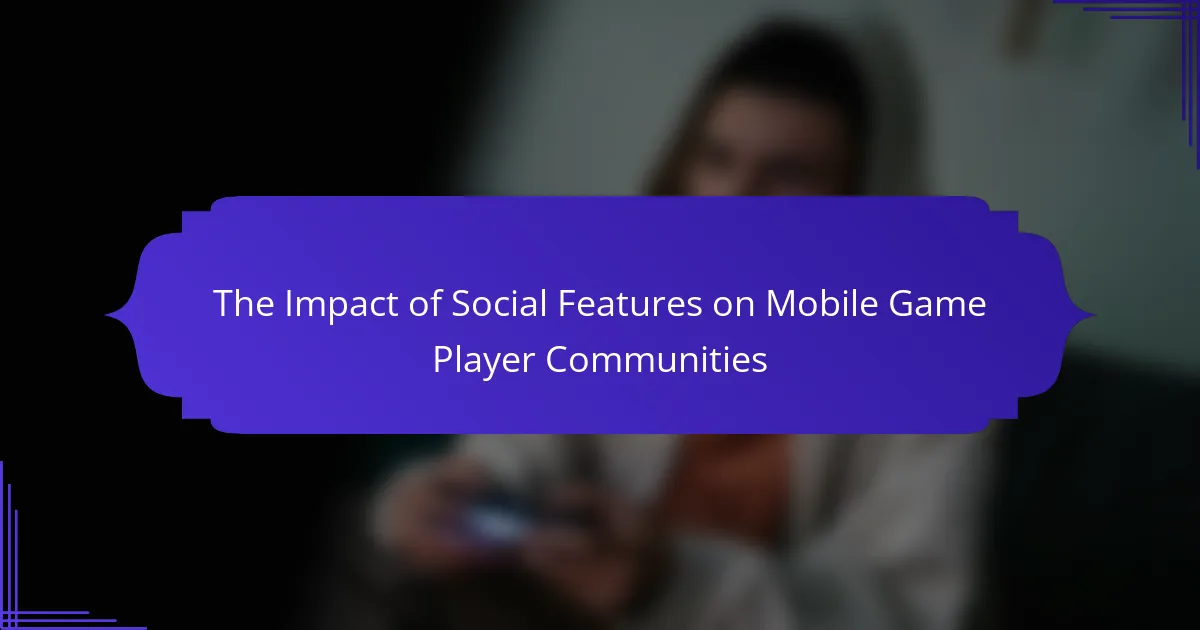Social features significantly enhance engagement in mobile game player communities by fostering interaction and competition. This article explores how these features create a sense of belonging, address demographic responses, and measure community dynamics through engagement metrics. It also examines the challenges of user engagement and privacy while highlighting emerging trends that drive player loyalty.
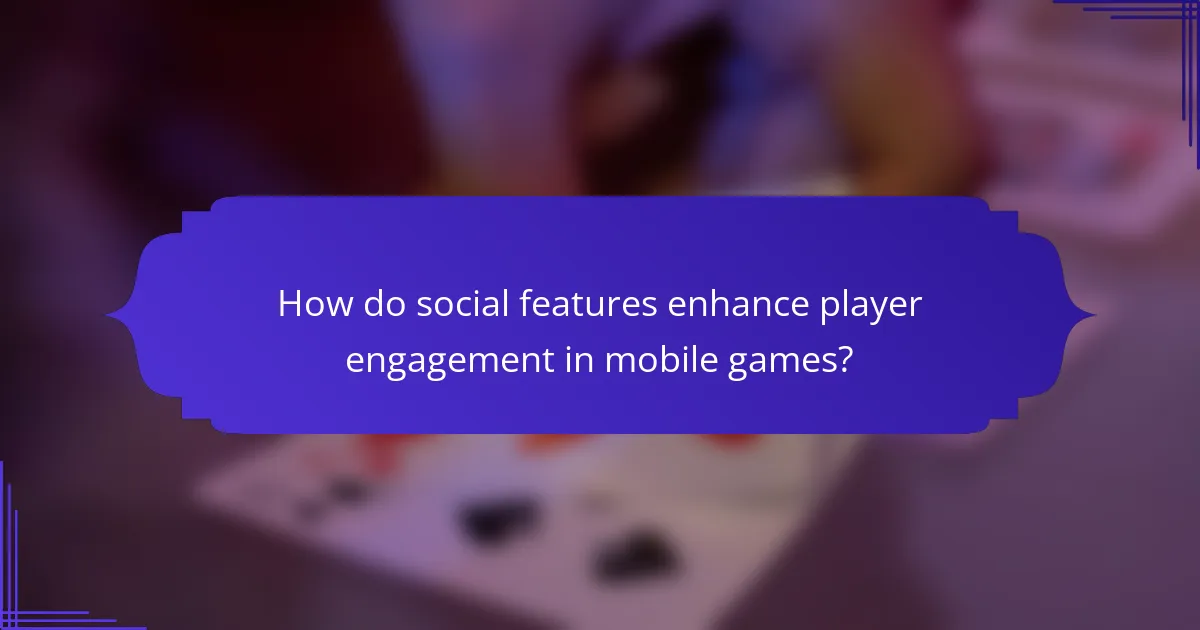
How do social features enhance player engagement in mobile games?
Social features significantly enhance player engagement in mobile games by fostering community interaction and competition. These features, such as chat systems, leaderboards, and social media integration, create a sense of belonging among players. They encourage collaboration through team-based challenges and events, leading to increased retention rates.
Moreover, social features facilitate sharing achievements, which can attract new players through word-of-mouth. Research indicates that games with robust social components see a 30% increase in daily active users. Unique attributes like personalized friend lists and in-game messaging further deepen player connections. As a result, these features transform gaming from a solitary experience into a vibrant, interactive community.
What role does community interaction play in player retention?
Community interaction significantly enhances player retention in mobile games. Engaging social features foster connections, creating loyalty and a sense of belonging. Players are more likely to return when they feel part of an active community. For instance, in-game chat and cooperative gameplay encourage collaboration, making players invested in their social ties. Moreover, regular events and challenges can stimulate ongoing participation, reinforcing player commitment. Ultimately, strong community dynamics can lead to higher retention rates, as players enjoy shared experiences and support.
Which social features are most effective for building player loyalty?
Social features that foster interaction, competition, and community are most effective for building player loyalty. Features such as leaderboards, social sharing, and in-game chat enhance engagement and create a sense of belonging. Leaderboards promote healthy competition, motivating players to improve their skills. Social sharing allows players to showcase achievements, attracting new users and retaining existing ones. In-game chat facilitates communication, strengthening community ties and encouraging collaboration. These elements collectively contribute to a loyal player base, enhancing the overall gaming experience.
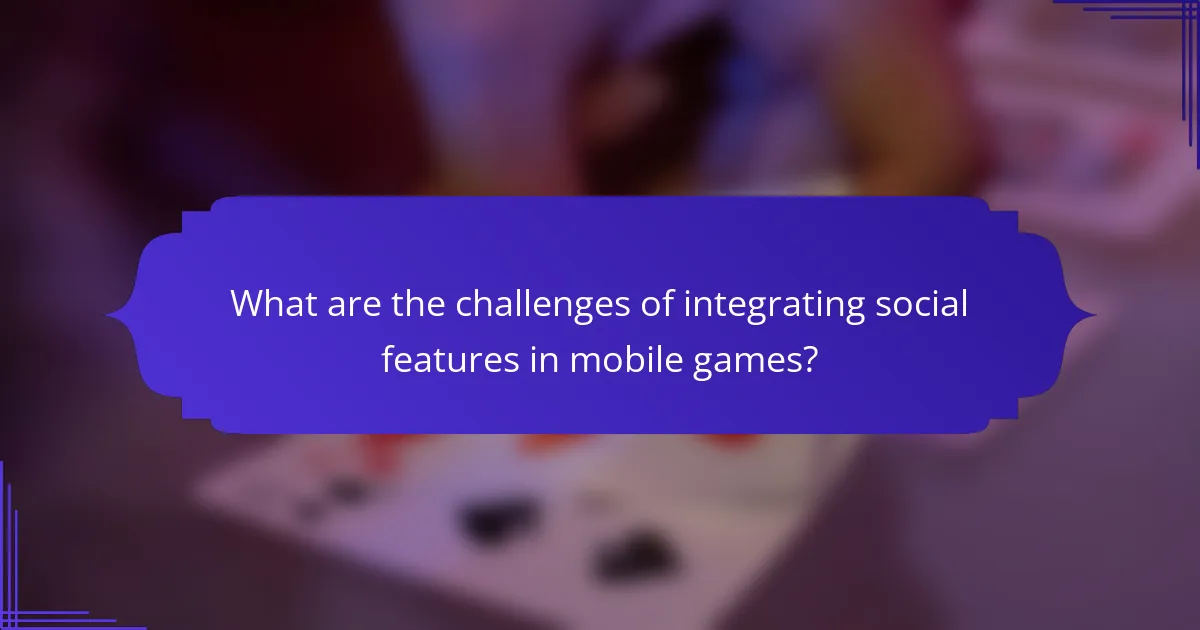
What are the challenges of integrating social features in mobile games?
Integrating social features in mobile games presents challenges such as maintaining user engagement, ensuring privacy, and balancing competitive dynamics. These issues can lead to fragmented player communities and hinder overall game success.
User engagement can decline if social features do not enhance gameplay or foster connections. Privacy concerns arise when players share personal information, leading to distrust. Additionally, competitive elements may create tension among players, impacting the community’s atmosphere.
Addressing these challenges requires careful design and ongoing feedback from players to create a positive and inclusive environment.
How do privacy concerns affect player participation in social aspects?
Privacy concerns significantly reduce player participation in social features of mobile games. Players often fear data misuse, leading to reluctance in engaging with community aspects. A study found that 65% of gamers hesitate to share personal information due to privacy worries. This hesitance limits social interaction and can diminish overall game enjoyment. Developers must prioritize transparent data practices to foster a sense of security and encourage participation.
What technical issues arise when implementing social features?
Technical issues in implementing social features include server stability, data privacy concerns, and user experience challenges. Server stability is crucial, as increased user interactions can lead to crashes or slow performance. Data privacy concerns arise with user-generated content and personal information sharing, necessitating robust security measures. User experience challenges include ensuring seamless integration of social features without disrupting gameplay. These factors can significantly impact player retention and community engagement.
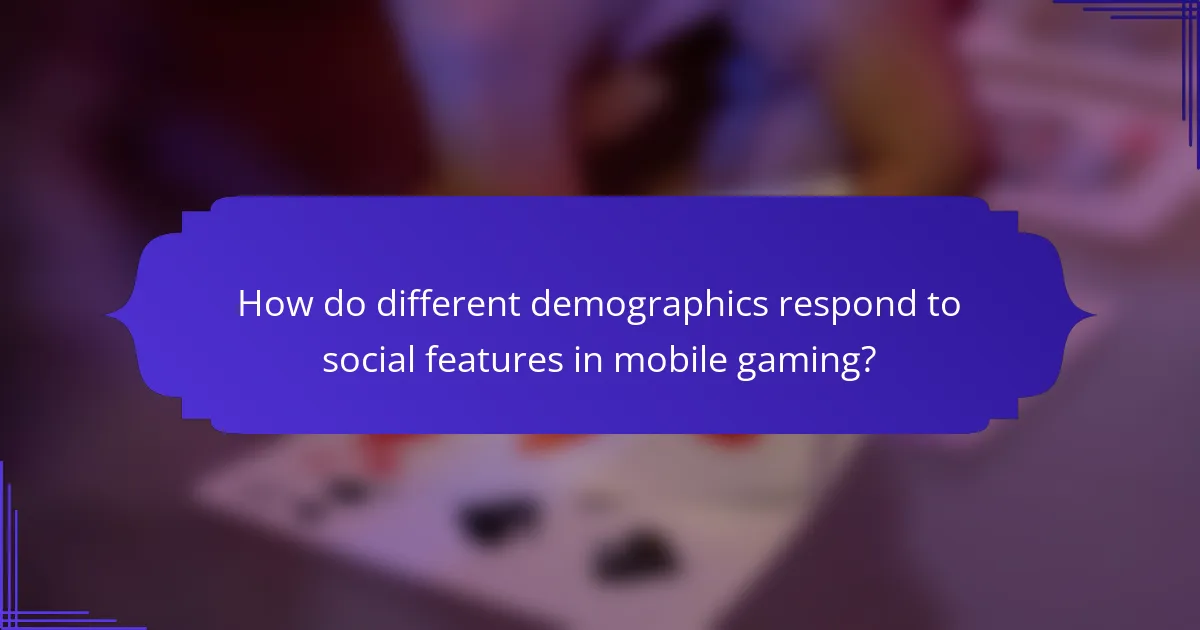
How do different demographics respond to social features in mobile gaming?
Different demographics respond uniquely to social features in mobile gaming, influencing community engagement. Younger players often favor competitive elements, while older demographics appreciate cooperative gameplay. Gender differences also emerge, with males typically engaging in more competitive social interactions than females, who may prefer socializing through collaborative tasks.
Cultural background impacts responses as well; for instance, players from collectivist cultures may prioritize group achievements over individual success. Additionally, social features that facilitate communication, such as chat systems and friend lists, enhance player retention across all demographics.
Understanding these variations allows developers to tailor social features effectively, fostering more inclusive and engaging player communities.
What unique preferences do younger players have regarding social interaction?
Younger players prefer social interaction that is instant, engaging, and community-focused. They value features like real-time chat, collaborative gameplay, and social sharing options. These preferences foster a sense of belonging and enhance their gaming experience. Additionally, younger players often seek opportunities to connect with friends and build networks within games, reflecting their desire for social engagement and interaction.
How do cultural differences influence social gaming experiences?
Cultural differences significantly shape social gaming experiences by influencing communication styles and community interactions. Players from diverse backgrounds may interpret game mechanics and social cues differently, affecting collaboration and competition. For instance, collectivist cultures may prioritize teamwork, while individualistic cultures might focus on personal achievement. These variations can lead to unique community dynamics, fostering either inclusivity or exclusivity. Additionally, language barriers can impact social engagement, altering how players connect and form relationships within games. Understanding these cultural nuances enhances player experience and promotes a more engaging gaming environment.
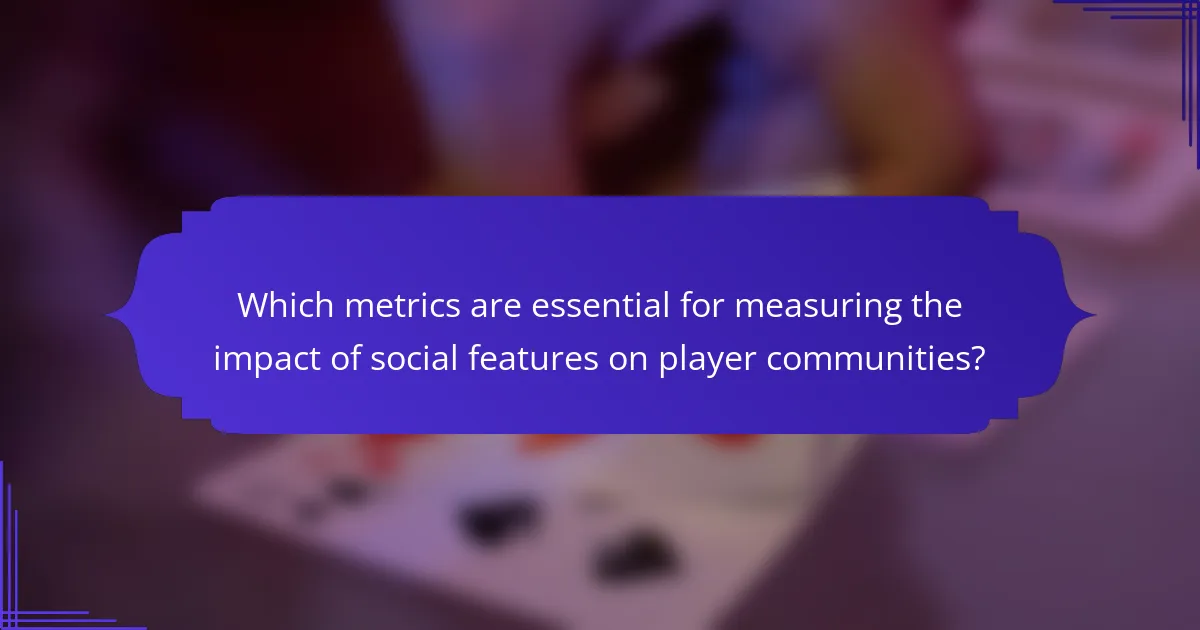
Which metrics are essential for measuring the impact of social features on player communities?
Engagement, retention, and social interaction metrics are essential for measuring the impact of social features on player communities. These metrics provide insights into how social features influence player behavior and community dynamics.
Engagement metrics include active users, session length, and frequency of interactions within social features. Retention metrics focus on the percentage of players returning after a set period, indicating the lasting appeal of social elements. Social interaction metrics assess the volume and quality of interactions among players, such as messages sent, groups formed, or events participated in.
By analyzing these metrics, game developers can refine social features to enhance community experience and foster player loyalty.
What data points indicate successful community engagement?
Successful community engagement in mobile game player communities is indicated by metrics such as active participation, social interactions, and retention rates. High engagement levels reflect players’ connection to the community and the game’s social features.
Key data points include the number of user-generated content submissions, frequency of in-game social interactions, and community event participation rates. For example, a community with over 70% of players regularly participating in discussions shows strong engagement.
Retention rates also serve as a critical indicator; communities with higher retention often foster deeper player relationships. Regular feedback loops, such as surveys, can provide insights into player satisfaction and areas for improvement.
Monitoring these metrics helps developers understand the effectiveness of social features and enhance community experiences.
How can developers track the effectiveness of social features?
Developers can track the effectiveness of social features through player engagement metrics, feedback, and community growth. Monitoring in-game interactions, such as friend requests and chat usage, provides insights into user behavior. Analyzing retention rates and session lengths helps assess the impact of social features on player communities. Additionally, surveys and social media sentiment analysis can reveal player satisfaction and areas for improvement.
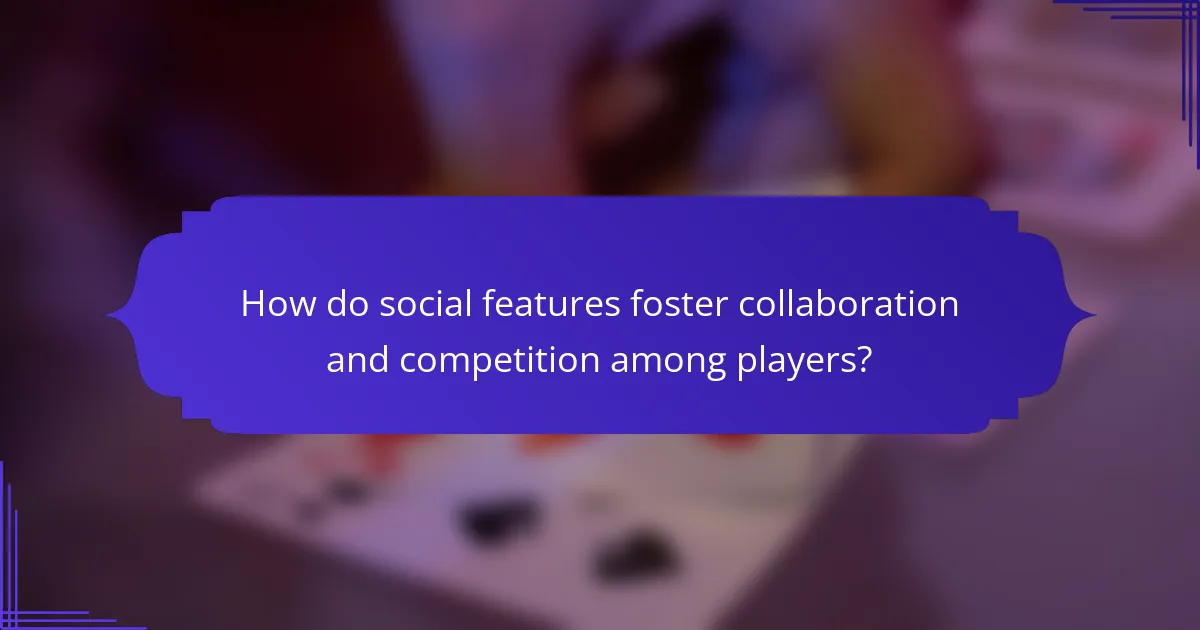
How do social features foster collaboration and competition among players?
Social features enhance collaboration and competition among players by creating shared goals and fostering social interaction. These features, such as leaderboards and team challenges, encourage players to engage with one another. As a result, players form communities that promote cooperative strategies and healthy competition.
Leaderboards display rankings based on player performance, motivating individuals to improve and compete for higher positions. Team-based events require collaboration, leading to stronger social bonds and shared achievements. The integration of chat functions allows players to communicate, share strategies, and build relationships, further enhancing the community aspect.
Additionally, social features can introduce unique attributes like player-generated content, allowing users to contribute their own ideas and creations. This not only fosters creativity but also encourages players to collaborate on projects, enhancing the overall gaming experience.
What types of collaborative gameplay are most popular?
Collaborative gameplay types like co-op, competitive multiplayer, and social games are highly popular. These formats enhance player interactions and foster community building. Co-op gameplay emphasizes teamwork, while competitive multiplayer promotes rivalry. Social games often incorporate casual engagement, further enriching player experiences.
How do competitive elements influence social dynamics in mobile games?
Competitive elements significantly enhance social dynamics in mobile games by fostering collaboration and rivalry among players. These features create a sense of community and engagement, driving interactions that can lead to lasting relationships.
Leaderboards and rankings instill a competitive spirit, motivating players to improve their skills. As a result, players often form alliances or groups to strategize and achieve common goals. This collaboration enhances the gaming experience, making it more enjoyable and immersive.
In-game events and challenges further amplify social interactions. Players can participate in cooperative tasks or compete against each other, which strengthens community bonds. These dynamics often lead to the emergence of dedicated player communities that support each other beyond the game itself.
The integration of chat systems and social media sharing options allows players to communicate easily, share achievements, and celebrate milestones. This connectivity is crucial for maintaining an active player base and encouraging new players to join.

What are the emerging trends in social features for mobile games?
Emerging trends in social features for mobile games enhance player engagement and community building. Key trends include integrated social media sharing, real-time multiplayer interactions, and personalized in-game events. These features foster collaboration and competition among players, increasing retention rates. Unique attributes like cross-platform connectivity allow players to interact regardless of device, expanding community reach. As a result, mobile games increasingly prioritize social experiences to drive player loyalty and satisfaction.
How are developers leveraging social media integration in gaming?
Developers are enhancing mobile game player communities through social media integration, fostering engagement and interaction. Social features like sharing achievements, leaderboards, and in-game chat promote collaboration and competition among players. This integration creates a sense of belonging and community, driving player retention and satisfaction. For instance, games that allow players to share content on platforms like Facebook or Twitter often see increased visibility and user acquisition. Additionally, user-generated content encourages creativity and investment in the game, enhancing overall player experience.
What innovative social features are expected to shape the future of mobile gaming?
Innovative social features will enhance player engagement and community building in mobile gaming. Features like real-time collaboration, integrated social media sharing, and cross-platform play are expected to foster deeper connections among players. Additionally, personalized matchmaking and community events will create tailored experiences that encourage participation. As a result, these advancements will shape a more interactive and inclusive gaming environment.
What best practices should developers follow when designing social features?
Developers should prioritize user engagement, community building, and seamless integration when designing social features in mobile games. Effective practices include creating intuitive user interfaces, encouraging player interaction through features like chat and forums, and implementing reward systems for social participation.
Additionally, ensuring data privacy and security fosters trust within player communities. Regular updates based on player feedback can enhance the social experience, making players feel valued and heard. Lastly, integrating social media sharing options can broaden community reach and engagement.
